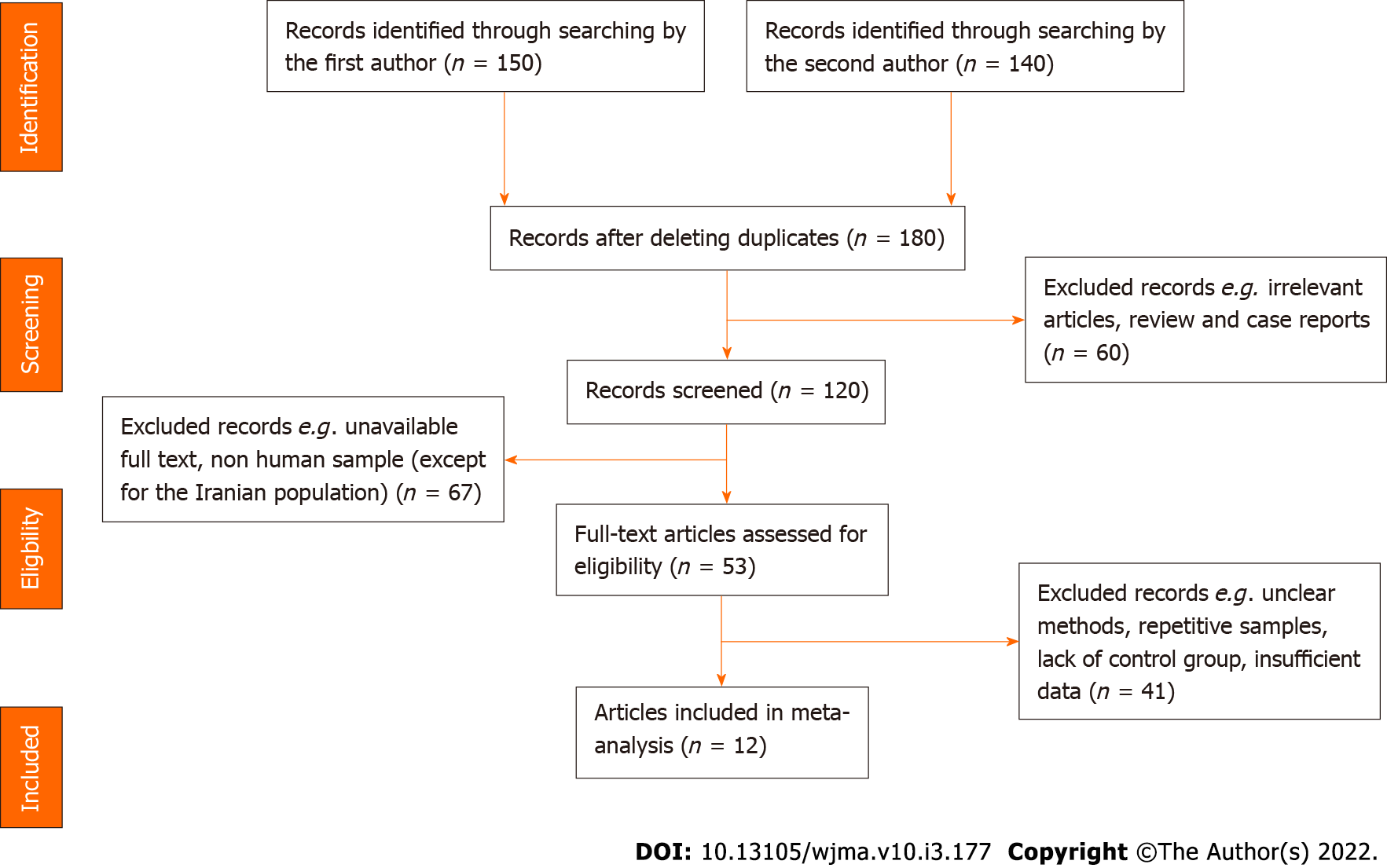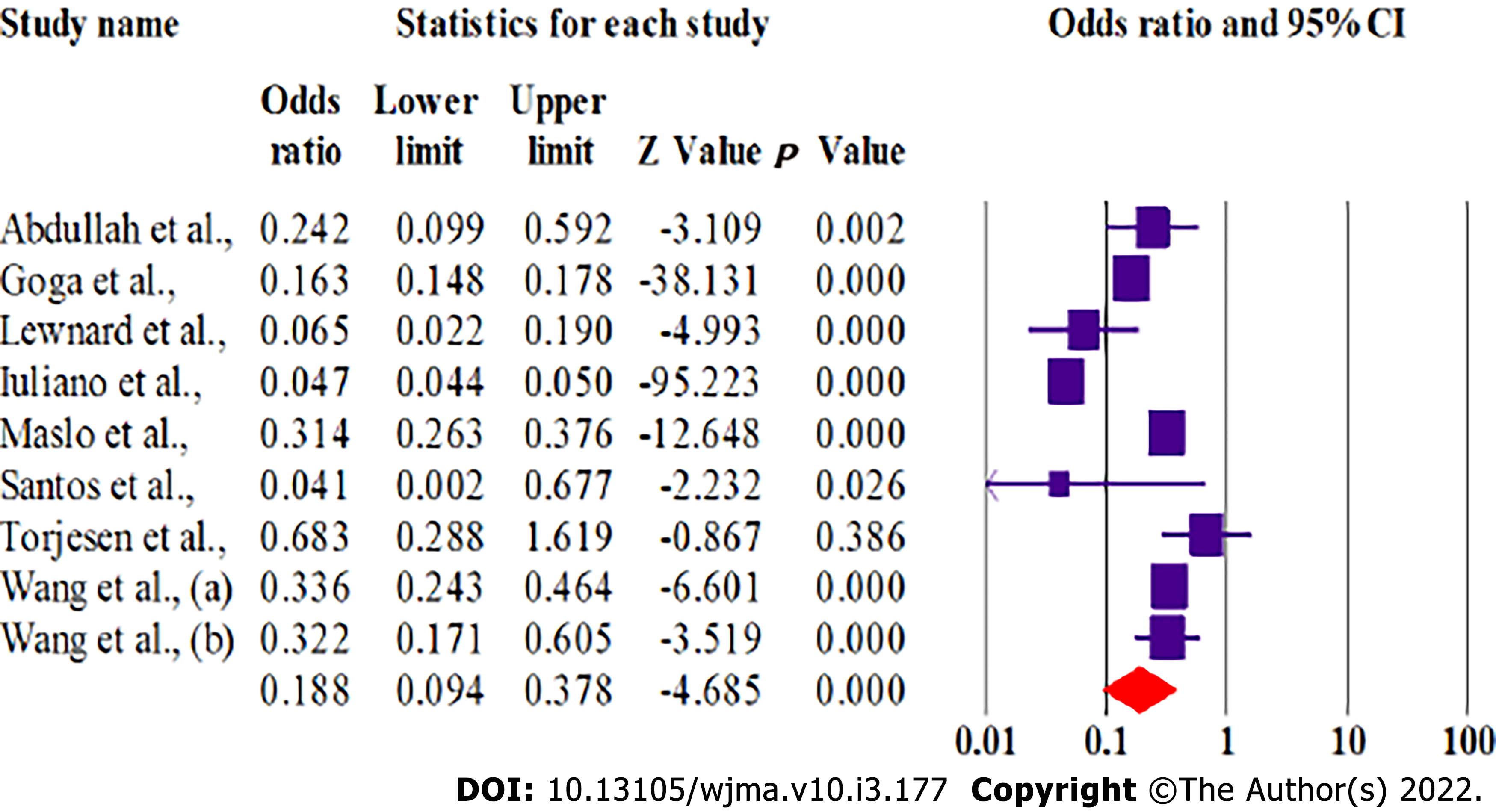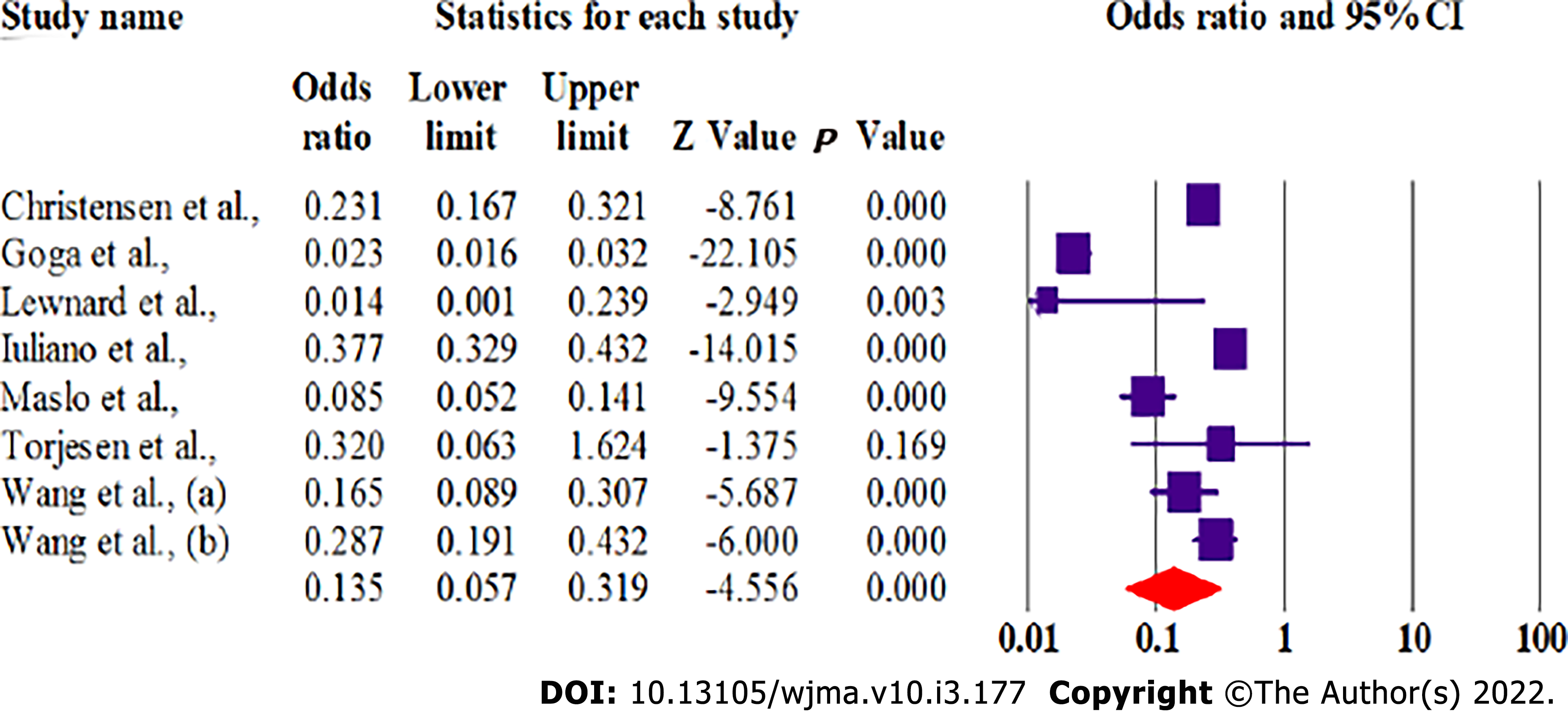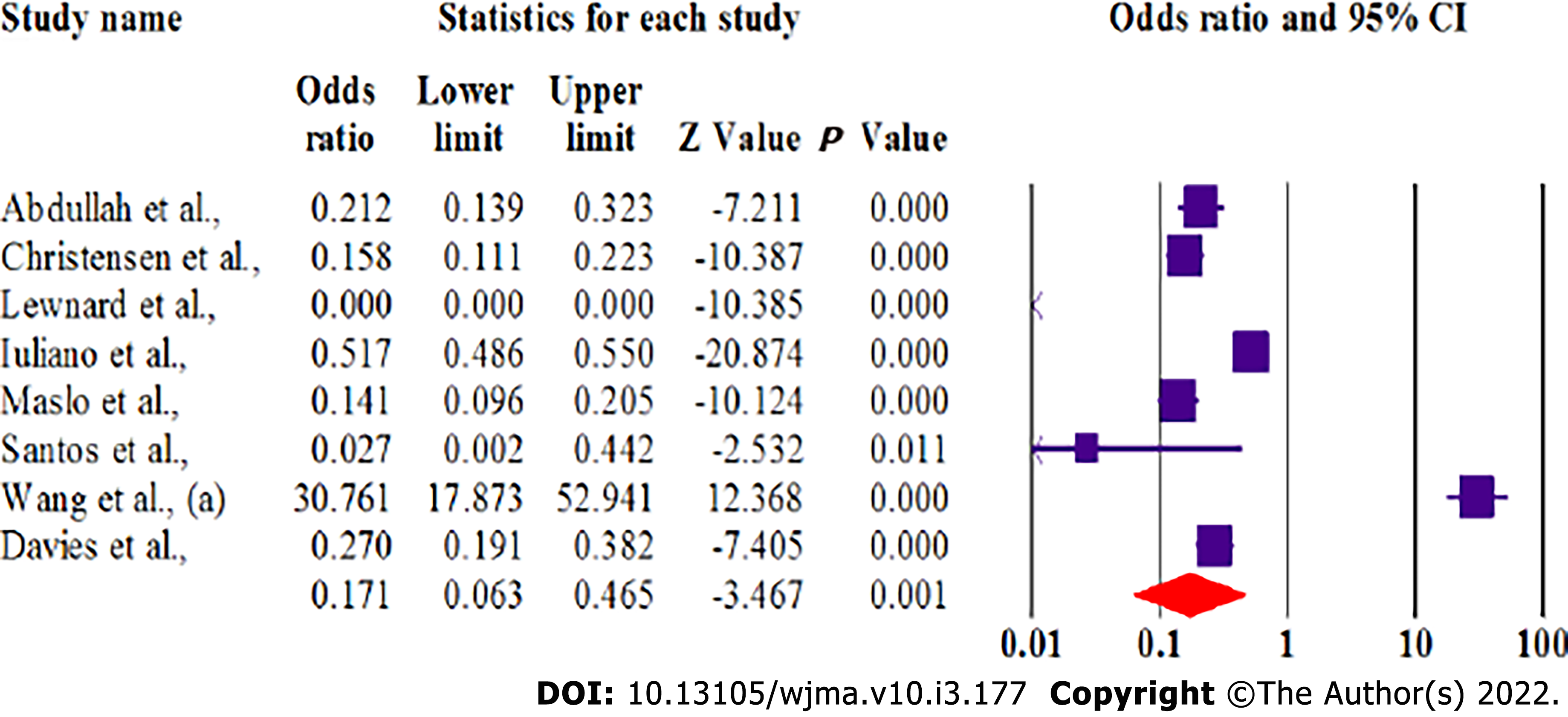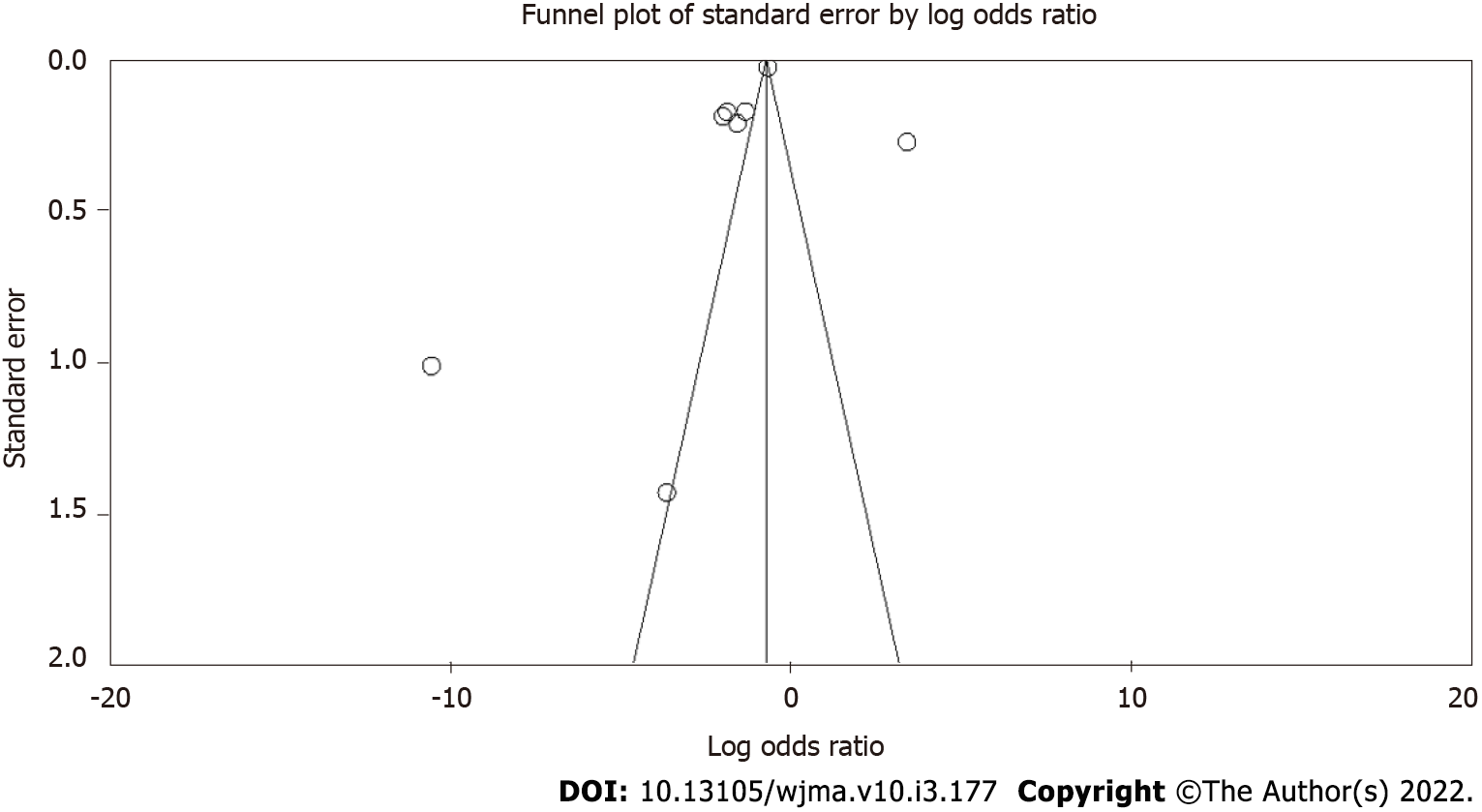Published online Jun 28, 2022. doi: 10.13105/wjma.v10.i3.177
Peer-review started: March 24, 2022
First decision: April 28, 2022
Revised: May 15, 2022
Accepted: June 24, 2022
Article in press: June 24, 2022
Published online: June 28, 2022
Processing time: 102 Days and 20.4 Hours
Omicron (B.1.1.529) is a severe acute respiratory syndrome coronavirus 2 (SARS-CoV-2) variant of concern; however, there is no comprehensive analysis regarding clinical features, disease severity, or clinical outcomes of this variant.
To compare the clinical characteristics of infection with omicron and previous variants of SARS-CoV-2.
We searched major international databases consisting ISI Web of Science, PubMed, Scopus, MedRxiv, and Reference Citation Analysis to collect the potential relevant documents. Finally, clinical features, e.g., death rate, intensive care unit (ICU) admission, length of hospitalization, and mechanical ventilation, of infection with SARS-CoV-2 omicron variant compared with previous variants were assessed using odds ratio and 95% confidence intervals by Comprehensive Meta-Analysis software version 2.2.
A total of 12 articles met our criteria. These investigated the clinical outcomes of infection with omicron variant compared with other variants such as alpha, beta and delta. Our results suggested that ICU admission, need for mechanical ventilation, and death rate were significantly lower for omicron than previous variants. In addition, the average length of hospitalization during the omicron wave was significantly shorter than for other variants.
The infectivity of omicron variant was higher than for previous variants due to several mutations, particularly in the spike protein. However, disease severity was mild to moderate compared previous variants.
Core Tip: Severe acute respiratory syndrome coronavirus 2 (SARS-CoV-2) omicron (B.1.1.529) is a variant of concern that was first identified on 24 November 2021 as a new global threat. However, due to the lack of comprehensive statistical analysis, clinical characteristics and disease outcomes of infection with omicron variant have remained unknown. Hence, the comparison of clinical profile between cases infected with this new variant and previous variants will lead to the establishment of a strategy regarding appropriate management and global control of this variant.
- Citation: Karbalaei M, Keikha M. Clinical outcomes of the omicron variant compared with previous SARS-CoV-2 variants; meta-analysis of current reports. World J Meta-Anal 2022; 10(3): 177-185
- URL: https://www.wjgnet.com/2308-3840/full/v10/i3/177.htm
- DOI: https://dx.doi.org/10.13105/wjma.v10.i3.177
Coronavirus disease 2019 (COVID-19) is a global pandemic that first emerged from Wuhan, China in December 2019. According to the World Health Organization (WHO), so far > 378 million cases, as well as 5.67 million deaths have occurred due to severe acute respiratory syndrome coronavirus 2 (SARS-CoV-2) infection[1]. On 24 November 2021, the Network for Genomics Surveillance in South Africa (NGS-SA) reported a new variant of this virus from Gauteng Province, named omicron (B.1.1.529); the new variant was confirmed by WHO on 25 November 2021[2,3].
The omicron variant rapidly replaced the previous variants in South Africa and spread to other countries, so it quickly became a dominant variant. In the USA, approximately 95% of all new cases of COVID-19 were diagnosed as being caused by the omicron variant by January 2022[4,5].
The genome of this variant contains 26–32 mutations in the spike gene as well as 45–52 amino acid substitutions. these mutations are associated with increases in viral characteristics such as transmissibility, immune escape, and S gene target failure (SGTF). SGTF is due to the 69 to 70 deletion in the S gene of B.1.1.7[6-8]. Early studies have shown the inefficacy of current vaccines (vaccination schemes and booster doses) and the higher rate of re-infection with the omicron variant[9,10]. Based on animal model findings, the severity of symptoms as well as the viral load of the omicron variant were lower compared to the previously reported variants of SARS-CoV-2[11,12]. Clinical reports from Scotland, England, Canada, and the USA have also confirmed animal experiments[13-16]. However, the fourth global wave of COVID-19 caused by the omicron variant was not associated with increased hospitalization or death in comparison with previous SARS-CoV-2 variants[17].
Understanding the clinical characteristics, susceptibility factors, and immune response against the new SARS-CoV-2 variants could be useful strategies in managing these viruses and development of novel treatment options. In this study, we evaluated the clinical severity of SARS-CoV-2 omicron variant compared with previous variants.
We searched global databases such as ISI Web of Science, PubMed, Scopus, MedRxiv, and Reference Citation Analysis (https://www.referencecitationanalysis.com/) using MeSH keywords such as “Omicron”, “COVID-19”, “SARS-CoV-2”, “Disease severity”, “Variant of concern”, “ICU”, “Intensive care unit”, and “fourth wave”. We retrieved all potential studies related to the clinical severity of SARS-CoV-2 omicron variant regardless of language and publication date. All eligible documents were carefully screened; required data including mean age, immunization status, mortality rate, intensive care unit (ICU) admission, length of hospitalization, and mechanical ventilation are summarized in Table 1. We also reviewed the bibliography of documents to avoid missing relevant articles. Finally, the severity of COVID-19 caused by omicron compared with previous SARS-CoV-2 variants was evaluated using odds ratio (OR) and 95% confidence interval (CI). We used a random-effect size due to the presence of significant heterogeneity (I2 index and Cochrane P value test). Data were pooled using Comprehensive Meta-Analysis software version 2.2 (Biostat, Englewood, NJ, USA).
| First author | Country | Mean age | Immunization | Death rate | ICU admission | Length of stay | Ventilation | Number of cases | Ref. | |||||||
| Omicron | Previous variants | Omicron | Previous variants | Omicron | Previous variants | Omicron | Previous variants | Omicron | Previous variants | Omicron | Previous variants | Omicron | Previous variants | |||
| Abdullah | South Africa | 39 | 49.8 | NA | NA | 4.5% | 21.3% | 1% | 4.3% | 4 | 8.8 | NA | NA | 466 | 3962 | [18] |
| Cloete | South Africa | 4.2 | NA | NA | NA | 4 | NA | 7 | NA | 3.2 | NA | 7 | NA | 6287 | NA | [19] |
| Christensen | USA | 44.3 | 50.0 | 2497 | 101 | 38 | 170 | NA | NA | 3.2 | 5.1 | 49 | 144 | 4468 | 3149 | [20] |
| Davies | South Africa | NA | NA | HR:0.41, 95%CI: 0.29-0.59 | HR: 0.27, 95%CI: 0.19-0.38 | NA | NA | NA | NA | NA | NA | 5144 | 11609 | [21] | ||
| Goga | South Africa | 33 | 55 | NA | NA | NA | NA | 3% | 16% | 3 | 6 | 0.2% | 8% | 17650 | 22888 | [22] |
| Lewnard | USA | NA | NA | 6,981 | 784 | 1 | 12 | 4 | 20 | 5.5 | 15.8 | 0 | 11 | 52297 | 16982 | [23] |
| Iuliano | USA | NA | NA | NA | NA | 1854 | 1924 | 24776 | 24774 | 3 | 5 | 358 | 503 | 48238 | 25873 | [24] |
| Maslo | South Africa | 36 | 53 | 235 | NA | 27 | 520 | 180 | 1104 | 3 | 8 | 16 | 431 | 971 | 2628 | [25] |
| Santos | Portugal | 37.1 | 43.4 | 295 | 201 | 0 | 26 | 0 | 17 | 3.7 | 8.6 | NA | NA | 6581 | 9397 | [26] |
| Torjesen | UK | NA | NA | NA | NA | NA | NA | 9.9% | 14% | 1.7 | 6.6 | 2% | 5.8% | NA | NA | [27] |
| Wang | USA | 36.4 | 36.1 | 2.4% | 3.1% | 23 | 30 | 0.26% | 0.78% | NA | NA | 0.07% | 0.43% | 14054 | 563884 | [28] |
| Wang | USA | 1.49 | 1.73 | NA | NA | NA | NA | 0.14% | 0.43% | NA | NA | 0.33% | 1.15% | 7201 | 63203 | [29] |
A total of 12 studies investigated the clinical outcomes of infection with SARS-CoV-2 omicron variant compared with other variants such as alpha, beta and delta (Figure 1). Eligible studies were performed in South Africa, USA, Portugal and UK from 2021 to 2022[18-29]. We pooled the data of 887 132 cases with positive PCR test for SARS-CoV-2, including 163 457 cases positive for omicron variant, as well as 723 675 cases positive for other variants.
The mean age of patients infected with omicron variant was 28.93 ± 15 years. The frequency of events such as ICU admission, need for mechanical ventilation, and death rate for omicron variant was 0.8% (95% CI: 0.2%–3.7%; I2: 99.89; P = 0.01; Egger’s P = 0.01; Begg’s P = 0.29), 0.2% (95% CI: 0.1%–0.5%; I2: 95.75; P = 0.01; Egger’s P = 0.16; Begg’s P = 0.26), and 0.4% (95% CI: 0.1%–1.0%; I2: 98.47; P = 0.01; Egger’s P = 0.01; Begg’s P = 0.45), respectively. The average length of hospitalization for omicron was significantly less than for other variants (3.36 ± 1 d vs. 7.98 ± 3 d; P < 0.05). The incidence of omicron infection among fully vaccinated individuals was 12.9% (95% CI: 5%–27%; I2: 99.89; P = 0.01; Egger’s P = 0.22; Begg’s P = 0.40). the current findings revealed that the severity of infections caused by omicron was less than for previous infections caused by alpha, beta, and delta variants. The current findings are consistent with similar reports[30,31]. In comparing the fourth wave of COVID-19 caused by the omicron variant with previous waves, it should be said that the mean age for patients infected with omicron was ~13 years (28.93 ± 15 years), which was less than that for other variants (41.29 ± 17 years). There was a significant reduction in ICU admission (OR: 0.18; 95% CI: 0.094–0.37; P = 0.01; I2: 99.05; P = 0.01; Egger’s P = 0.2; Begg’s P value: 0.07) (Figure 2). Our results suggested a significant reduction in the need for mechanical ventilation (OR: 0.135; 95% CI: 0.05–0.31; P = 0.01; I2: 97.24; P = 0.01; Egger’s P = 0.12; Begg’s P = 0.26) among omicron cases (Figure 3). The mortality rate also declined among patients infected with omicron variant (OR: 0.17; 95% CI: 0.06–0.46; P = 0.01; I2: 98.32; P = 0.01; Egger’s P = 0.44; Begg’s P = 0.71) compared with previous variants (Figure 4).
We found that the severity of COVID-19 caused by the SARS-CoV-2 omicron variant was significantly less than for previous variants; however, there was significant heterogeneity that could be due to differences in several factors such as study design, geographical region, time for assessment of clinical outcomes, and diverse conditions of included cases; publication bias was also significant. Recently, Zhao et al[32], showed that the omicron variant is less dependent on the TMPRSS2-mediated entry pathway, which leads to less-efficient replication and decreased viral load within the lungs. In addition, the omicron variant is more susceptible to interferons than other variants are, especially the delta variant[33]. Similar evidence could be a reasonable explanation for the lower severity of COVID-19 with the omicron variant, as confirmed by numerous observational studies[15].
The omicron variant nucleotide sequence has several mutations, especially 32 single substitutions in the spike protein that cause resistance to neutralizing antibodies, as well as inefficiency of current vaccines[34-36]. We revealed that omicron variant causes less severity of COVID-19 than previous variants; however, heterogeneity and publication bias were significant in our estimations (Figure 5). Further studies need to confirm the present findings.
A new global increase in COVID-19 has been accompanied by the emergence of the SARS-CoV-2 omicron variant that is associated with less disease severity, as well as fewer ICU admissions, shorter hospitalization, and lower mortality rate. Nonetheless, there is limited information about the effect of omicron on children, pregnant women, and immunodeficient individuals. Overall, omicron has been considered as the most contagious SARS-CoV-2 variant that affects children and young adults more than other groups. Continuation of the current situation can have deadly consequences for these age groups.
Omicron (B.1.1.529) is a new variant of concern of severe acute respiratory syndrome coronavirus 2 (SARS-CoV-2); however, there is no comprehensive analysis regarding clinical features, disease severity, and clinical outcomes of infection with this variant.
There is insufficient evidence regarding clinical characteristics, standard therapeutic regimen, and efficacy of currently available vaccines against the omicron variant.
This study was a comprehensive review and statistical analysis to compare the clinical characteristics of infection with the omicron and previous variants.
We searched major international databases consisting ISI Web of Science, PubMed, Scopus, and MedRxiv to collect the potential relevant documents. Finally, clinical features, e.g., death rate, intensive care unit (ICU) admission, length of hospitalization, and need for mechanical ventilation of patients infected with omicron variant compared with previous variants, were assessed.
Twelve articles met our criteria. These studies investigated the clinical outcomes of infection with SARS-CoV-2 omicron variant compared with other variants such as alpha, beta and delta. Our results suggested that ICU admission, need for mechanical ventilation, and death rate were significantly lower for omicron than previous variants. In addition, the average length of hospitalization during the omicron wave was significantly shorter than for other variants.
The infectivity of the omicron variant was much higher than for previous variants due to the presence of several mutations, particularly in the spike protein. However, disease severity was mild to moderate disease compared with previous variants.
We revealed that the disease severity of infection with omicron was lower than for previous variants. However, this variant was more contagious. Nevertheless, further investigation with larger samples is needed to confirm the present findings.
Provenance and peer review: Unsolicited article; Externally peer reviewed.
Peer-review model: Single blind
Specialty type: Infectious diseases
Country/Territory of origin: Iran
Peer-review report’s scientific quality classification
Grade A (Excellent): 0
Grade B (Very good): B
Grade C (Good): C
Grade D (Fair): 0
Grade E (Poor): 0
P-Reviewer: Cure E, Turkey; Lelisho ME, Ethiopia S-Editor: Liu JH L-Editor: Kerr C P-Editor: Liu JH
| 1. | Okonji OC, Okonji EF, Mohanan P, Babar MS, Saleem A, Khawaja UA, Essar MY, Hasan MM. Marburg virus disease outbreak amidst COVID-19 in the Republic of Guinea: A point of contention for the fragile health system? Clin Epidemiol Glob Health. 2022;13:100920.. [RCA] [PubMed] [DOI] [Full Text] [Full Text (PDF)] [Cited by in Crossref: 11] [Cited by in RCA: 27] [Article Influence: 6.8] [Reference Citation Analysis (0)] |
| 2. | Roessler A, Riepler L, Bante D, von Laer D, Kimpel J. SARS-CoV-2 B. 1.1. 529 variant (Omicron) evades neutralization by sera from vaccinated and convalescent individuals. medRxiv. 2021;. [DOI] [Full Text] |
| 3. | Rahimi F, Talebi Bezmin Abadi A. Is Omicron the last SARS-CoV-2 Variant of Concern? Arch Med Res. 2022;53:336-338. [RCA] [PubMed] [DOI] [Full Text] [Full Text (PDF)] [Cited by in Crossref: 13] [Cited by in RCA: 6] [Article Influence: 2.0] [Reference Citation Analysis (0)] |
| 4. | Burki TK. Omicron variant and booster COVID-19 vaccines. Lancet Respir Med. 2022;10:e17. [RCA] [PubMed] [DOI] [Full Text] [Full Text (PDF)] [Cited by in Crossref: 89] [Cited by in RCA: 188] [Article Influence: 62.7] [Reference Citation Analysis (0)] |
| 5. | Control CfD, Prevention. COVID data tracker: variant proportions. Atlanta, GA2021. 2021. Available from: https://covid.cdc.gov/covid-data-tracker/#datatracker-home. |
| 6. | Wu C, Yin W, Jiang Y, Xu HE. Structure genomics of SARS-CoV-2 and its Omicron variant: drug design templates for COVID-19. Acta Pharmacol Sin. . [RCA] [DOI] [Full Text] [Full Text (PDF)] [Cited by in Crossref: 13] [Cited by in RCA: 68] [Article Influence: 22.7] [Reference Citation Analysis (0)] |
| 7. | Brierley AS, Fernandes PG, Brandon MA, Armstrong F, Millard NW, McPhail SD, Stevenson P, Pebody M, Perrett J, Squires M, Bone DG, Griffiths G. Antarctic krill under sea ice: elevated abundance in a narrow band just south of ice edge. Science. 2002;295:1890-1892. [RCA] [PubMed] [DOI] [Full Text] [Cited by in Crossref: 192] [Cited by in RCA: 83] [Article Influence: 3.6] [Reference Citation Analysis (0)] |
| 8. | Abdulnoor M, Eshaghi A, Perusini SJ, Broukhanski G, Corbeil A, Cronin K, Fittipaldi N, Forbes JD, Guthrie JL, Kus JV, Li Y, Majury A, Mallo GV, Mazzulli T, Melano RG, Olsha R, Sullivan A, Tran V, Patel SN, Allen VG, Gubbay JB. Real-Time RT-PCR Allelic Discrimination Assay for Detection of N501Y Mutation in the Spike Protein of SARS-CoV-2 Associated with B.1.1.7 Variant of Concern. Microbiol Spectr. 2022;10:e0068121. [RCA] [PubMed] [DOI] [Full Text] [Full Text (PDF)] [Cited by in Crossref: 5] [Cited by in RCA: 2] [Article Influence: 0.7] [Reference Citation Analysis (0)] |
| 9. | Nemet I, Kliker L, Lustig Y, Zuckerman N, Erster O, Cohen C, Kreiss Y, Alroy-Preis S, Regev-Yochay G, Mendelson E, Mandelboim M. Third BNT162b2 Vaccination Neutralization of SARS-CoV-2 Omicron Infection. N Engl J Med. 2022;386:492-494. [RCA] [PubMed] [DOI] [Full Text] [Full Text (PDF)] [Cited by in Crossref: 272] [Cited by in RCA: 314] [Article Influence: 104.7] [Reference Citation Analysis (0)] |
| 10. | Papanikolaou V, Chrysovergis A, Ragos V, Tsiambas E, Katsinis S, Manoli A, Papouliakos S, Roukas D, Mastronikolis S, Peschos D, Batistatou A, Kyrodimos E, Mastronikolis N. From delta to Omicron: S1-RBD/S2 mutation/deletion equilibrium in SARS-CoV-2 defined variants. Gene. 2022;814:146134. [RCA] [PubMed] [DOI] [Full Text] [Full Text (PDF)] [Cited by in Crossref: 35] [Cited by in RCA: 93] [Article Influence: 31.0] [Reference Citation Analysis (0)] |
| 11. | Bentley EG, Kirby A, Sharma P, Kipar A, Mega DF, Bramwell C, Penrice-Randal R, Prince T, Brown JC. , Zhou J. SARS-CoV-2 Omicron-B. 1.1. 529 Variant leads to less severe disease than Pango B and Delta variants strains in a mouse model of severe COVID-19. bioRxiv. 2021;. [DOI] [Full Text] |
| 12. | Naranbhai V, Nathan A, Kaseke C, Berrios C, Khatri A, Choi S, Getz MA, Tano-Menka R, Ofoman O, Gayton A, Senjobe F, Denis KJS, Lam EC, Garcia-Beltran WF, Balazs AB, Walker BD, Iafrate AJ, Gaiha GD. T cell reactivity to the SARS-CoV-2 Omicron variant is preserved in most but not all prior infected and vaccinated individuals. medRxiv. 2022;. [RCA] [PubMed] [DOI] [Full Text] [Cited by in Crossref: 17] [Cited by in RCA: 16] [Article Influence: 5.3] [Reference Citation Analysis (0)] |
| 13. | Sheikh A, Kerr S, Woolhouse M, McMenamin J, Robertson C; EAVE II Collaborators. Severity of omicron variant of concern and effectiveness of vaccine boosters against symptomatic disease in Scotland (EAVE II): a national cohort study with nested test-negative design. Lancet Infect Dis. 2022;. [RCA] [PubMed] [DOI] [Full Text] [Full Text (PDF)] [Cited by in Crossref: 191] [Cited by in RCA: 158] [Article Influence: 52.7] [Reference Citation Analysis (0)] |
| 14. | Nyberg T, Ferguson NM, Nash SG, Webster HH, Flaxman S, Andrews N, Hinsley W, Bernal JL, Kall M, Bhatt S, Blomquist P, Zaidi A, Volz E, Aziz NA, Harman K, Funk S, Abbott S; COVID-19 Genomics UK (COG-UK) consortium, Hope R, Charlett A, Chand M, Ghani AC, Seaman SR, Dabrera G, De Angelis D, Presanis AM, Thelwall S. Comparative analysis of the risks of hospitalisation and death associated with SARS-CoV-2 omicron (B.1.1.529) and delta (B.1.617.2) variants in England: a cohort study. Lancet. 2022;399:1303-1312. [RCA] [PubMed] [DOI] [Full Text] [Full Text (PDF)] [Cited by in Crossref: 835] [Cited by in RCA: 866] [Article Influence: 288.7] [Reference Citation Analysis (0)] |
| 15. | Ulloa AC, Buchan SA, Daneman N, Brown KA. Early estimates of SARS-CoV-2 Omicron variant severity based on a matched cohort study, Ontario, Canada. MedRxiv. 2021;. [DOI] [Full Text] |
| 16. | Jansen L, Tegomoh B, Lange K, Showalter K, Figliomeni J, Abdalhamid B, Iwen PC, Fauver J, Buss B, Donahue M. Investigation of a SARS-CoV-2 B.1.1.529 (Omicron) Variant Cluster - Nebraska, November-December 2021. MMWR Morb Mortal Wkly Rep. 2021;70:1782-1784. [RCA] [PubMed] [DOI] [Full Text] [Full Text (PDF)] [Cited by in Crossref: 79] [Cited by in RCA: 125] [Article Influence: 31.3] [Reference Citation Analysis (0)] |
| 17. | Wolter N, Jassat W, Walaza S, Welch R, Moultrie H, Groome M, Amoako DG, Everatt J, Bhiman JN, Scheepers C, Tebeila N, Chiwandire N, du Plessis M, Govender N, Ismail A, Glass A, Mlisana K, Stevens W, Treurnicht FK, Makatini Z, Hsiao NY, Parboosing R, Wadula J, Hussey H, Davies MA, Boulle A, von Gottberg A, Cohen C. Early assessment of the clinical severity of the SARS-CoV-2 omicron variant in South Africa: a data linkage study. Lancet. 2022;399:437-446. [RCA] [PubMed] [DOI] [Full Text] [Full Text (PDF)] [Cited by in Crossref: 811] [Cited by in RCA: 707] [Article Influence: 235.7] [Reference Citation Analysis (0)] |
| 18. | Abdullah F, Myers J, Basu D, Tintinger G, Ueckermann V, Mathebula M, Ramlall R, Spoor S, de Villiers T, Van der Walt Z, Cloete J, Soma-Pillay P, Rheeder P, Paruk F, Engelbrecht A, Lalloo V, Myburg M, Kistan J, van Hougenhouck-Tulleken W, Boswell MT, Gray G, Welch R, Blumberg L, Jassat W. Decreased severity of disease during the first global omicron variant covid-19 outbreak in a large hospital in tshwane, south africa. Int J Infect Dis. 2022;116:38-42. [RCA] [PubMed] [DOI] [Full Text] [Full Text (PDF)] [Cited by in Crossref: 132] [Cited by in RCA: 285] [Article Influence: 71.3] [Reference Citation Analysis (0)] |
| 19. | Cloete J, Kruger A, Masha M, du Plessis NM, Mawela D, Tshukudu M, Manyane T, Komane L, Venter M, Jassat W. Rapid rise in paediatric COVID-19 hospitalisations during the early stages of the Omicron wave, Tshwane District, South Africa. medRxiv. 2021;. [DOI] [Full Text] |
| 20. | Christensen PA, Olsen RJ, Long SW, Snehal R, Davis JJ, Ojeda Saavedra M, Reppond K, Shyer MN, Cambric J, Gadd R, Thakur RM, Batajoo A, Mangham R, Pena S, Trinh T, Kinskey JC, Williams G, Olson R, Gollihar J, Musser JM. Signals of Significantly Increased Vaccine Breakthrough, Decreased Hospitalization Rates, and Less Severe Disease in Patients with Coronavirus Disease 2019 Caused by the Omicron Variant of Severe Acute Respiratory Syndrome Coronavirus 2 in Houston, Texas. Am J Pathol. 2022;192:642-652. [RCA] [PubMed] [DOI] [Full Text] [Full Text (PDF)] [Cited by in Crossref: 162] [Cited by in RCA: 144] [Article Influence: 48.0] [Reference Citation Analysis (0)] |
| 21. | Davies MA, Kassanjee R, Rosseau P, Morden E, Johnson L, Solomon W, Hsiao NY, Hussey H, Meintjes G, Paleker M, Jacobs T, Raubenheimer P, Heekes A, Dane P, Bam JL, Smith M, Preiser W, Pienaar D, Mendelson M, Naude J, Schrueder N, Mnguni A, Roux SL, Murie K, Prozesky H, Mahomed H, Rossouw L, Wasserman S, Maughan D, Boloko L, Smith B, Taljaard J, Symons G, Ntusi N, Parker A, Wolter N, Jassat W, Cohen C, Lessells R, Wilkinson RJ, Arendse J, Kariem S, Moodley M, Vallabhjee K, Wolmarans M, Cloete K, Boulle A. Outcomes of laboratory-confirmed SARS-CoV-2 infection in the Omicron-driven fourth wave compared with previous waves in the Western Cape Province, South Africa. medRxiv. 2022;. [RCA] [PubMed] [DOI] [Full Text] [Full Text (PDF)] [Cited by in Crossref: 35] [Cited by in RCA: 32] [Article Influence: 10.7] [Reference Citation Analysis (0)] |
| 22. | Goga A, Bekker LG, Garret N, Reddy T, Yende-Zuma N, Fairall L, Moultrie H, Takalani A, Trivelli V, Faesen M. Breakthrough Covid-19 infections during periods of circulating Beta, Delta and Omicron variants of concern, among health care workers in the Sisonke Ad26. COV2. S vaccine trial, South Africa. medRxiv. 2021;. [DOI] [Full Text] |
| 23. | Lewnard JA, Hong VX, Patel MM, Kahn R, Lipsitch M, Tartof SY. Clinical outcomes among patients infected with Omicron (B. 1.1. 529) SARS-CoV-2 variant in southern California. medRxiv. 2022.. [DOI] [Full Text] |
| 24. | Iuliano AD, Brunkard JM, Boehmer TK, Peterson E, Adjei S, Binder AM, Cobb S, Graff P, Hidalgo P, Panaggio MJ, Rainey JJ, Rao P, Soetebier K, Wacaster S, Ai C, Gupta V, Molinari NM, Ritchey MD. Trends in Disease Severity and Health Care Utilization During the Early Omicron Variant Period Compared with Previous SARS-CoV-2 High Transmission Periods - United States, December 2020-January 2022. MMWR Morb Mortal Wkly Rep. 2022;71:146-152. [RCA] [PubMed] [DOI] [Full Text] [Full Text (PDF)] [Cited by in Crossref: 105] [Cited by in RCA: 328] [Article Influence: 109.3] [Reference Citation Analysis (0)] |
| 25. | Maslo C, Friedland R, Toubkin M, Laubscher A, Akaloo T, Kama B. Characteristics and Outcomes of Hospitalized Patients in South Africa During the COVID-19 Omicron Wave Compared With Previous Waves. JAMA. 2022;327:583-584. [RCA] [PubMed] [DOI] [Full Text] [Cited by in Crossref: 268] [Cited by in RCA: 364] [Article Influence: 121.3] [Reference Citation Analysis (0)] |
| 26. | Peralta-Santos A, Rodrigues EF, Moreno J, Ricoca V, Casaca P, Fernandes E, Gomes JP, Ferreira R, Isidro J, Pinto M. Omicron (BA. 1) SARS-CoV-2 Variant Is Associated With Reduced Risk of Hospitalization and Length of Stay Compared With Delta (B. 1.617. 2).. [DOI] [Full Text] |
| 27. | Torjesen I. Covid-19: Omicron variant is linked to steep rise in hospital admissions of very young children. BMJ. 2022;376:o110. [RCA] [PubMed] [DOI] [Full Text] [Cited by in Crossref: 16] [Cited by in RCA: 35] [Article Influence: 11.7] [Reference Citation Analysis (0)] |
| 28. | Wang L, Berger NA, Kaelber DC, Davis PB, Volkow ND, Xu R. Comparison of outcomes from COVID infection in pediatric and adult patients before and after the emergence of Omicron. medRxiv. 2022;. [RCA] [PubMed] [DOI] [Full Text] [Full Text (PDF)] [Cited by in Crossref: 81] [Cited by in RCA: 76] [Article Influence: 25.3] [Reference Citation Analysis (0)] |
| 29. | Wang L, Berger NA, Kaelber DC, Davis PB, Volkow ND, Xu R. COVID infection severity in children under 5 years old before and after Omicron emergence in the US. medRxiv. 2022;. [RCA] [PubMed] [DOI] [Full Text] [Full Text (PDF)] [Cited by in Crossref: 49] [Cited by in RCA: 48] [Article Influence: 16.0] [Reference Citation Analysis (0)] |
| 30. | Del Rio C, Omer SB, Malani PN. Winter of Omicron-The Evolving COVID-19 Pandemic. JAMA. 2022;327:319-320. [RCA] [PubMed] [DOI] [Full Text] [Cited by in Crossref: 121] [Cited by in RCA: 143] [Article Influence: 47.7] [Reference Citation Analysis (0)] |
| 31. | Madhi S, Kwatra G, Myers JE, Jassat W, Dhar N, Mukendi CK, Nana A, Blumberg L, Welch R, Ngorima-Mabhena N. South African population immunity and severe Covid-19 with omicron variant. MedRxiv. 2021;. [DOI] [Full Text] |
| 32. | Zhao H, Lu L, Peng Z, Chen LL, Meng X, Zhang C, Ip JD, Chan WM, Chu AW, Chan KH, Jin DY, Chen H, Yuen KY, To KK. SARS-CoV-2 Omicron variant shows less efficient replication and fusion activity when compared with Delta variant in TMPRSS2-expressed cells. Emerg Microbes Infect. 2022;11:277-283. [RCA] [PubMed] [DOI] [Full Text] [Full Text (PDF)] [Cited by in Crossref: 295] [Cited by in RCA: 286] [Article Influence: 95.3] [Reference Citation Analysis (0)] |
| 33. | Bojkova D, Widera M, Ciesek S, Wass MN, Michaelis M, Cinatl J Jr. Reduced interferon antagonism but similar drug sensitivity in Omicron variant compared to Delta variant of SARS-CoV-2 isolates. Cell Res. 2022;32:319-321. [RCA] [PubMed] [DOI] [Full Text] [Full Text (PDF)] [Cited by in Crossref: 72] [Cited by in RCA: 79] [Article Influence: 26.3] [Reference Citation Analysis (0)] |
| 34. | Song Y, Masaki F. Preparation for the challenge of heavily mutated Omicron variant. Clin Transl Med. 2021;11:e679. [RCA] [PubMed] [DOI] [Full Text] [Full Text (PDF)] [Cited by in Crossref: 16] [Cited by in RCA: 19] [Article Influence: 4.8] [Reference Citation Analysis (0)] |
| 35. | Hoffmann M, Krüger N, Schulz S, Cossmann A, Rocha C, Kempf A, Nehlmeier I, Graichen L, Moldenhauer AS, Winkler MS, Lier M, Dopfer-Jablonka A, Jäck HM, Behrens GMN, Pöhlmann S. The Omicron variant is highly resistant against antibody-mediated neutralization: Implications for control of the COVID-19 pandemic. Cell. 2022;185:447-456.e11. [RCA] [PubMed] [DOI] [Full Text] [Full Text (PDF)] [Cited by in Crossref: 484] [Cited by in RCA: 652] [Article Influence: 217.3] [Reference Citation Analysis (0)] |
| 36. | Tada T, Zhou H, Dcosta BM, Samanovic MI, Chivukula V, Herati RS, Hubbard SR, Mulligan MJ, Landau NR. Increased resistance of SARS-CoV-2 Omicron variant to neutralization by vaccine-elicited and therapeutic antibodies. EBioMedicine. 2022;78:103944. [RCA] [PubMed] [DOI] [Full Text] [Full Text (PDF)] [Cited by in Crossref: 112] [Cited by in RCA: 103] [Article Influence: 34.3] [Reference Citation Analysis (0)] |









